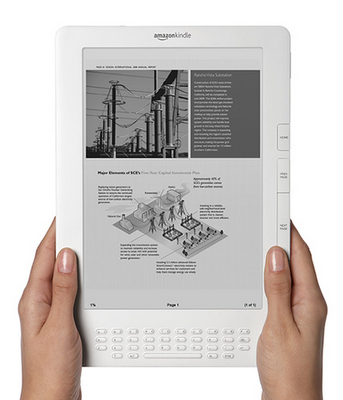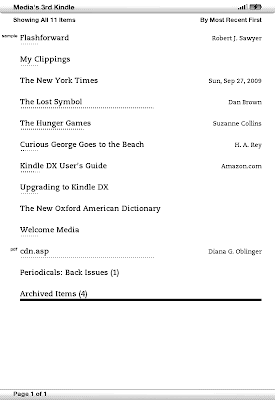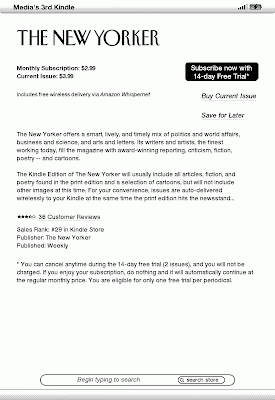Monday, October 12, 2009
by jethrojones
Twitter version: The Kindle is not for education, unless it is for all in education. That is, everyone has to have their own or it won't work.

Kindle DX from Amazon.com

The list of books on the home screen of the Kindle 2.

Subscription to "The New Yorker"
Luckily, the district I work for is forward thinking enough to allow me to buy some Kindles to test the waters. So, for the four people on my team, we bought two Kindle 2's and two Kindle DX's.
The first weekend we got them, my wife and I each read a book. It totaled about 800 pages. I really like the reading experience. It is very fluid and easy to use. My eyes didn't get tired, and when I read with my contacts in, it didn't hurt or give me a headache (reading on my iPod Touch or on a computer screen does give me a headache sometimes). There isn't a backlight, so reading in the dark is not as fun.

With the text-to-speech feature that is on select books and Amazon-converted PDFs, you can have the device read to you in a (annoying) computer voice. Obviously, no substitute for real audiobooks (which the Kindle plays, also), but for me it was good enough when I wanted to keep reading what I wanted between locations.
The Kindle will play Audible audiobooks or regular MP3 files, and it has a web browser. The web experience is slow, and I don't really care for it.
Obviously, that is not the purpose of the device or the wireless chip. Its purpose is to be able to deliver books wirelessly to the device, which is the best thing about it. For users and for Amazon, this results in being able to buy books quickly and easily. Good for readers who want books wherever they are. Good for Amazon who makes money when you buy a book.

The Kindle Store on the DX.
What will make it great for schools:
- Drop the price. Sell it for $49 (or heaven forbid, free!) and let subsidies from textbooks pay for the rest.
- Flexible licenses. Let the school or district pay thousands of dollars for the textbooks and send them to all the devices, so that the kids/families own the Kindle, not the school.
- Or, get rid of the wireless. The problem with schools owning the Kindle is that you need to have the account logged in to be able to read the book, which is the same password that you have to have to order books. This represents a giant financial loss to schools. Now if they make it like the iPod Touch or iPhone, where you have to input your password every time you purchase, that would eliminate most problems.
- Kindles aren't conducive to sharing, which is why there should be one for every kid.
There are some other problems with the Kindles in education. It is very difficult to take notes on the device, and very difficult to jump through a book. Reading footnotes that are in the back of a book for example is, however, surprisingly easy with the links that are inserted. But, if you want to read from different chapters, there is no navigation that makes it easy.
One benefit of the Kindle is that there is a free iPod Touch/iPhone app that allows you to read books that you have purchased for your Kindle. Reading on that small of a screen is not as bad as you might imagine. You can read in portrait or landscape mode, and it is really quite pleasant. With the iPhone/iPod Touch, you have a backlit screen, and color. Well, as much color as the scan of the book allows. See the picture from Curious George for an example:
"The Lost Symbol" and "Curious George" on the Kindle for iPhone App, with the three different font colors.
As you can see, the man with the yellow hat is really just a man in a hat without color. Some book covers will make it over in color (like "The Lost Symbol" for example).
Comparing the functionality and cost and limitations of the iPod Touch and the Kindle, you have to admit that it seems silly to pay $60 more for a device that is completely limited to only reading books...
...Unless, of course, if all you want is a book reader. And, in education, that is a very real possibility. Wireless delivery is great, but raises concerns when money and the lack of a filter on a device that a 13 year-old can use privately. For that, we might have a case for the Sony Reader Pocket and Touch editions. I haven't played with either of these very much, but they do have some distinct advantages over the Kindle for education:
- You cannot purchase books directly from the device.
- There is no internet connectivity.
- All you can do is read books.
- You can check out books from your local library (and perhaps your school library, also).
You can see Sony's comparison of the two devices
here.
We have decided that we cannot even justify the cost of the Kindle DX and so we are going to return those to Amazon. They are too much for too little to us. We are going to get some evaluation units of the Sony Readers and maybe when the
B&N/Plastic Logic shindig comes out, we will see how that will work in an education setting.
Have a Good Life.











 Facebook/Jethro
Facebook/Jethro Linkedin/Jethro Jones
Linkedin/Jethro Jones Twitter/jethrojones
Twitter/jethrojones YouTube/mrjoneseng
YouTube/mrjoneseng Del.icio.us/jethrojones
Del.icio.us/jethrojones Wikipedia/mrjoneseng
Wikipedia/mrjoneseng GMail/Jethro
GMail/Jethro